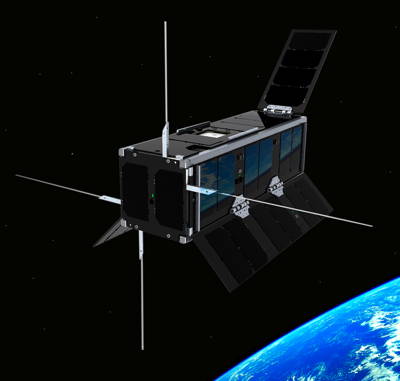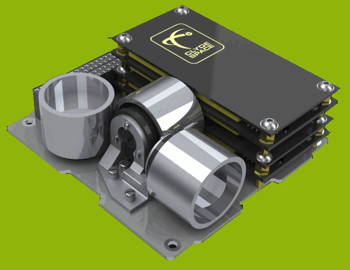Scotland’s first satellite, a compact device called the UKube-1 and weighing around 4kg, is due to blast into space in March on board a Russian Soyuz-2 rocket launched from the Baikonur Cosmodrome in Kazakhstan. UKube-1 is a member of a class of miniature spacecraft known as nano-satellites, or CubeSats, assembled from modules measuring just 10 x 10 x 10cm and having a mass of around 1kg. They are designed to offer a low-cost entry into space research and exploration. The Scottish satellite (shown below) will consist of three such cubes.

UKube-1 has been designed and built by Clyde Space at its facility on the West of Scotland Science Park in Glasgow. Funding has come from Clyde Space and its partners, who include the UK Space Agency, the Science and Technology Facilities Council and the Technology Strategy Board. Scottish Enterprise has helped to develop subsystem technologies including an advanced attitude determination and control system, deployable solar panels for increased on-board power, and the mission software.
The nano-satellite is one of the most advanced of its kind, and will carry six independent, advanced payloads. The UKube-1 mission is a pilot for a collaborative, national CubeSat programme that would bring UK industry together with academia to fly educational packages, test new technologies, and carry out new space research quickly and efficiently.
The UKube-1 payloads include: a GPS device for measuring plasmaspheric space weather; a camera to take images of the Earth and to test the effects of radiation on space hardware using a new generation of imaging sensor; and an experiment to demonstrate the feasibility of using cosmic radiation to improve the security of communications satellites and to flight-test lower-cost electronic systems. The satellite will also carry five experiments with which UK students and the public will be able to interact. There will also be an educational payload called FunCube aimed at enthusing and educating schoolchildren about space, electronics, physics and radio.

The satellite’s three-axis attitude control system (above) is based on torque reaction positioning system that uses a reaction/momentum flywheel driven by a brushless DC motor. By changing the speed of the flywheel, a reactionary torque is applied to rotate the CubeSat around an axis. Maintaining the rotation will stabilise the satellite.
Three of these reaction/momentum wheels are needed to provide full three-axis attitude control and stability. The motors being used to drive the reaction wheels are standard 20mm-diameter maxon motor brushless DC devices, which maxon has modified to withstand the arduous application environment. It also fitted the flywheels, and balanced the complete assemblies dynamically using a laser to remove material from the discs while they were spinning at 2,000 rpm.
“We have worked with maxon to ensure the brushless DC motors survive the high vibration and shock loads challenges seen on rocket launches, and the high thermal cycling and radiation levels experienced in orbit,” says Clyde Space’s CEO, Craig Clark.
“We are now able to offer our customers a full three-axis attitude control system based on off-the-shelf components,” he adds. “It is refreshing to see a customised off-the-shelf product meet this demanding environment, rather than use a bespoke-designed motor with the cost implications involved.”
Clyde Space is now working with maxon on improvements for future CubeSat attitude control systems, which could open up opportunities for further nano-satellite applications, such as earth observation with high-resolution cameras, or transmitting high bandwidth data. Other potential application areas include space science, astronomy and the verification of new technologies in orbit.

